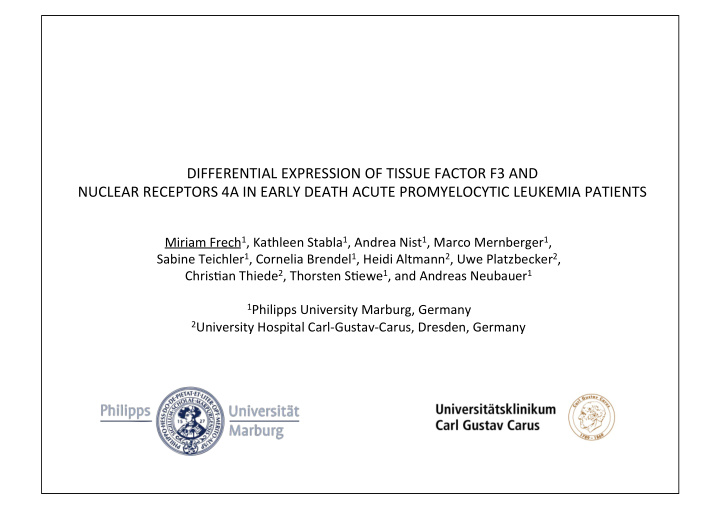



DIFFERENTIAL EXPRESSION OF TISSUE FACTOR F3 AND NUCLEAR RECEPTORS 4A IN EARLY DEATH ACUTE PROMYELOCYTIC LEUKEMIA PATIENTS Miriam Frech 1 , Kathleen Stabla 1 , Andrea Nist 1 , Marco Mernberger 1 , Sabine Teichler 1 , Cornelia Brendel 1 , Heidi Altmann 2 , Uwe Platzbecker 2 , ChrisMan Thiede 2 , Thorsten SMewe 1 , and Andreas Neubauer 1 1 Philipps University Marburg, Germany 2 University Hospital Carl-Gustav-Carus, Dresden, Germany
Acute promyelocy-c leukemia early death • 10-30% suffer an early death (ED) → hemorrhagic complicaMons → infecMons → differenMaMon syndrome Bleeding risk factors: • WBC > 10 x 10 9 /L blast count > 30 x 10 9 /L age > 60 years old impaired renal funcMon increased fibrinolysis severe thrombocytopenia • underlying mechanisms are unclear and successful treatment of ED in APL paMents could not be achieved so far • highly important to idenMfy novel factors implicated in the mechanisMc processes in APL-ED paMents
RNAseq approach: Comparison APL and APL-ED • 50 bp single-read RNA sequencing (RNAseq) cohort 1 Cohort 1 No. of APL pa-ents 16 - APL-ED (BCR1/BCR3) 6 (1/5) - APL (BCR1/BCR3) 10 (6/4) Age Median 59 (Range 37-73) Sex (m/f) 8/8 Treatment AIDA2000 (SAL) Sanz Score (No.) Low/Int 5 High 11
RNAseq approach: Comparison APL and APL-ED • 50 bp single-read RNA sequencing (RNAseq) cohort 1 Further validaMon cohorts Cohort 1 Cohort 2 Cohort 3 No. of APL pa-ents 16 10 14 - APL-ED (BCR1/BCR3) 6 (1/5) 4 (0/4) 4 (2/2) - APL (BCR1/BCR3) 10 (6/4) 6 (4/2) 10 (4/6) Age Median 59 (Range 37-73) Median 55 (Range 36-79) Median 55 (Range 37-79) Sex (m/f) 8/8 7/3 6/8 Treatment AIDA2000 (SAL) mostly AIDA2000 (SAL) SAL or APL0406 (AIDA, AML, Napoleon) Sanz Score (No.) Low/Int 5 Low/Int 5 Low/Int 5 High 11 High 5 High 3 N/A 4
Tissue factor F3-containing gene set significantly enriched • NegaMvely correlated with APL-ED → Is F3 less expressed in APL-ED than in APL?
Disrupted coagula-on cascade in APL-ED
Downregula-on of F3 is accompanied by downregula-on of NR4A family members NR4A2 F3 NR4A3 NR4A1
NR4A1, NR4A2 and NR4A3 are downregulated in ED-APL
NR4A family - nuclear receptor subfamily 4, group A • Nuclear transcripMon factors • NR4A1 and NR4A3 tumor suppressors in AML → abrogaMon causes AML development in a mouse model Mullican et al ., 2007 • NR4A2/3 induced by PKA → PKA important for ATRA-induced differenMaMon Zhao et al ., 2004; Nguyen et al ., 2013; Prince et al ., 2017 • NR4A1/2 heteromerizaMon with RXR Perlman & Jansson, 1995, Zemerstrom et al ., 1996 • NR4A1/3 act anMthromboMc via upregulaMon of thrombomodulin Morser, 2012; Yang et al ., 2016
Expression of short variance BCR3 of transloca-on t(15;17) associated with lower expression of NR4A2 and NR4A3
Expression of short variance BCR3 of transloca-on t(15;17) associated with lower expression of NR4A2 and NR4A3
ATRA treatment in NB4 cells inhibits F3 expression but induces NR4A2 and NR4A3 expression
ATRA treatment may induce NR4A expression in other AML subtypes
In AML low expression of NR4A2 and NR4A3 is associated with decreased OS Tomasson - Precog
Summary • F3 and NR4A1/2/3 are downregulated in APL-ED • decreased expression of NR4A2/3 is associated with short PML-RARα variant BCR3 • NR4A members may contribute to APL-ED phenotype • NR4A2/3 expression can be induced by ATRA and this may have therapeuMc implicaMons for other AML subtypes
Thanks to: Marburg Dresden Andreas Neubauer Uwe Platzbecker Kathleen Stabla Heidi Altmann Sabine Teichler ChrisMan Thiede Thorsten SMewe Andrea Nist Marco Mernberger Hamburg Cornelia Brendel Thomas M. Sternsdorf
Recommend
More recommend